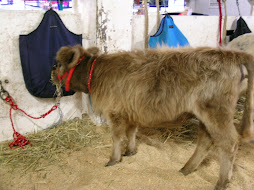August 6, 1928 - February 22, 1987
Two days before the Christmas Eve, April and I went to GOMA (Gallery of Modern Art ) for Andy Warhol’s exhibition. From the time I was a design student, I’ve been attracted to Warhol’s fame as a master of pop art. This is the first and largest show in Australia, and conincided with Brisbane’s GOMA's first birthday celebration.
300 pcs of Warhol’s work from early 1950s to the late 1980s are on display. The exhibition contains commercial works, illustrations, paintings to film making. Moreover, it also exhibits some of his private collection and personal interviews.
Before coming to this exhibition, I have two questions in mind and hope that I could find out from the exhibition.
1. Why do some people dislike his work and often regard them as “cliché” ?
2. Why did he become famous, what’s the value of his work to our culture?
First of all, I was not surprised by his iconic celebrity images, e.g. Marilyn Monroe of 1962, Jackie Kennedy of 1964, & Elvis of 1964. The early works in the 1960s seemed to be rather naïve. The series of “Mick Jagger, 1975” were better developed and more complex. The technique of using photographic images and turning them to silkscreen on canvas was new in art at that moment. Photography, strictly speaking ranked low in the art world, and silkscreen was developed in the 18th century but only restricted to fabrics printing and some commercial application, like advertising. Warhol knew how to grasp hold of current issues/news as a source and turned it to a theme to his artwork. Some people said that Warhol is an opportunist. He gathered the available material to regenerate it into something different. One example is “Red Race Riot, 1963” he used a press photo of a disaster, and turned it into acrylic to silkscreen on canvas.
On the other hand, Warhol tended to show great interests in accident photos, such as “129 DIE”, “WHITE CAR CRASH”, “GREEN BURNING CAR”, & “ORANGE CAR CRASH” The images were repeatedly loaded on canvases as a stereotype form. He presented a different angle viewing the photos, with the added colour plane, the horror of the crash became unimportant. The scene within the photos seemed to be elevated to some kind of message. He once said that he realized that everything he did was connected with death. What is the meaning behind this? Was this a ludic use of “cliché” ? Or was it his criticism of consumer attitudes of the endless material things that weigh upon us? Or to simply hide the fear that by the end of the 20th century we have become a society obsessed with consumption?
Although some people don’t understand or don’t appreciate his works, he responded by saying “ If you want to know all about Andy Warhol, just look at the surface of my paintings and films and me, there I am. There’s nothing behind it”
His work is “cliché”, there’s nothing behind it because what he created is what they had, such as Campbell soup and Heinz tomato ketchup are our daily food, our daily necessities. He used the most common medium and the most popular subjects for his art. He had no doubt putting them into it. He approved the mass commercialization. . The idea that he deals with the images just appropriately express what’s happening at that moment of time.
A look into the details of Warhol’s life style presented in the exhibition revealed that he paid a great deal of attention to his appearance. His habitual night life, acquaintance with gay club and the glitterati reflects the popular New York city lifestyle. As a result of the mass production, and commercialization, our material culture and living quality are getting sophisticated & complex. Andy Warhol just one of those who lived through the changes of our cultural history. He used his artistic skill to remark and identify the culture at that moment of his life. He chose to live within it but beneath the veneer of the glamourous bohemian outlook, he was in fact a distant observer of the world, as well as a realistic artist.
Wednesday, January 2, 2008
Subscribe to:
Post Comments (Atom)


































































No comments:
Post a Comment